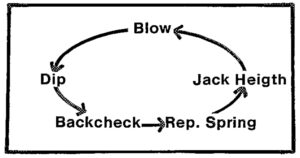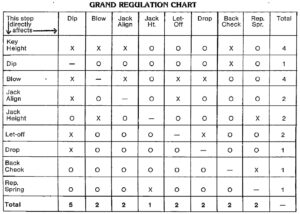QUIZ
- Does regulating the jack height to the balancier affect the strength of the repetition spring?
- Does regulating the let-off affect the backcheck distance?
- Which of the following affect the amount of after-touch: key height, blow, jack alignment, jack height, let-off, drop, backcheck, repetition spring?
Do you know for certain as a particular grand regulation procedure is performed, how it will affect the other procedures? Or which of the other procedures will alter the regulation just completed? For instance, in the jack to knuckle alignment, changing the jack will alter the let-off and the amount of aftertouch. But if the capstan is changed, the jack will have to be realigned again.
Say that you are about to completely recondition the action of a grand. Do you have an orderly, logical approach figured out so that nothing will be overlooked with a minimal amount of doubling back, wasting time? Action reconditioning can be much simplified by using a thorough, detailed checklist. The advantages are obvious. Most of us cannot take the time to go over an action in one sitting. Interruptions are bound to happen, whether it be for lunch, overnight or for two weeks. Frequently there is a loss of memory as to what has been done, where you are now, and what was next. With a checklist, you need only to mark where you are when the interruption occurs.
Unless grand regulation is something one does frequently, one probably does not have the proper sequence memorised. Manuals are available from the different manufacturers, but none of them give a complete list of things to do. Neither do they agree on the sequence to be used. For instance, one manufacturer says to level the keys and lay the dip first. Whereas another says to regulate the jack, let-off and blow first, and then level the keys and lay the dip. Many more differences can be found, too.
In general, are not all grand actions made similar today? Granted, they may have different designs of whippens, action rails, sostenuto systems, etc., but they all have parts working in the same functions (minor exceptions). Therefore, it should be possible to create a checklist to be used on all grand actions. One which has all of the different steps one must go through to properly recondition and regulate in the most efficient and logical way.
Here is a 50- point checklist for grands which does just that:
- I. Keys & Keyframe
- Tighten all screws, remove action and keys
- Sand keybed, apply talc or slipspray.
- Seat action on keyframe, repair stripped screw holes
- Bed keyframe, backrail, frontrail, studs; sand as necessary
- Align action rail distance if needed (whippen/hammer center pin)
- Remove action, polish front and centre rail pins, clean keyframe
- Put keys back on frame, check centre hole for loose/tight, correct
- Check buttons, ease or rebush as needed
- Check keys at frontrail pins, ease or rebush as needed
- Clean and buff keytops and fronts
- Square keytops, check for war page
- Adjust key height and level all 88
- Lay dip, at least 0.400 for now (0.450 for Steinway)
- Space keys
- II. Top Action (off of keyframe)
- (15) Check action centers, repin or shrink as needed
- (16) Travel hammers
- (17) Check hammer angle/shank warpage, correct
- (18) Reshape hammers
- (19) Regraphite jack top and balancier window
- (20) Space jack in window
- (21) Round and file knuckles, needle if hard
- (22) Clean repetition spring and groove (Steinway, Yamaha, Bosendorfer)
- (23) Round whippen felt if needed
- (24) Polish capstans
- (25) Clean knuckles and backchecks
- Ill. Alignments (installation back on keyframe)
- (26) Align action frame in piano (adjust keyframe stop block)
- (27) Align hammers to strings
- (28) Align and square whippens to knuckle
- (29) Align jack to knuckle core
- (30) Align and square backchecks to hammer tails
- IV. Touch
- (31) Jack heigth to the balancier
- (32) Blow
- (33) Let-off
- (34) Drop
- (35) Aftertouch
- (36) Backcheck distance
- (37) Repetition spring
- (38) Check gram weight resistance all 88 keys
- (39) Adjust key stoprail
- V. Dampers and pedals
- (40) Lube and releather trapwork
- (41) Check damper guide rail, ease or rebush as needed
- (42) Check damper lift from key (‘h blow)
- (43) Check damper lift from lifter rail
- (44) Adjust damper pedal rod length
- (45) Adjust damper pedal stop
- (46) Adjust damper stoprail
- (47) Check string level/damper seating
- (48) Sostenuto pedal rod length/ knife angle
- (49) Sostenuto assembly (tabs) aligned to knife
- (50) Shift pedal rod length and stop screw
A pretty extensive list. I am sure that it can be added to, but it should do in a pinch. Doesn’t it make more sense to do all of the lower keyframe together, and all of the upper action work together? Two people can be working on the same action at the same time. Once the alignment is started, it is easier to follow through and align all of the action parts. Section IV, the touch, is the most variable part of the procedure. Depending upon the needs of the action, you may not want to use this sequence.
As a help here, I constantly fall back on something I call the “circle of five steps”. There are five main regulation steps that are very interdependent upon each other:

If any of these five steps are very far off, it must be corrected first before any attempt is made to do Section IV. For instance, if the dip is shallow, it must be increased so that escapement can occur. Notice that step #13 in the checklist has laying the dip at 0.400 (0.450 if Steinway). Your first reaction was probably, “He doesn’t know what he’s talking about, that’s way too deep”. Sure it is. But I find that making the dip too deep as I begin the regulation insures that escapement will always occur even if the blow, let off, jack height, etc., is way off (which is normal). Of course when the aftertouch is set, all I do is add punchings. Which is a lot easier than trying to take punchings out!
Doing this is my preference, and I expect many to disagree with it. I won’t go into a big lecture now; that comes in a few months in a blog post called “Key Dip Versus Hammer Blow”. Going back to the “circle of five steps”, notice that the key height, let-off, and drop are not in the picture. These three steps do not affect anything other than aftertouch, assuming that they are at least in the ballpark.
Remember the quiz at the beginning? It all boils down to knowing how one step affects the others, and how the others affect it. Once you know this, regulation becomes a simple matter of a checklist to see that nothing is overlooked. Using a check now and then insures that what has already been regulated has not been altered. A checkup and a check, that makes it easy.
